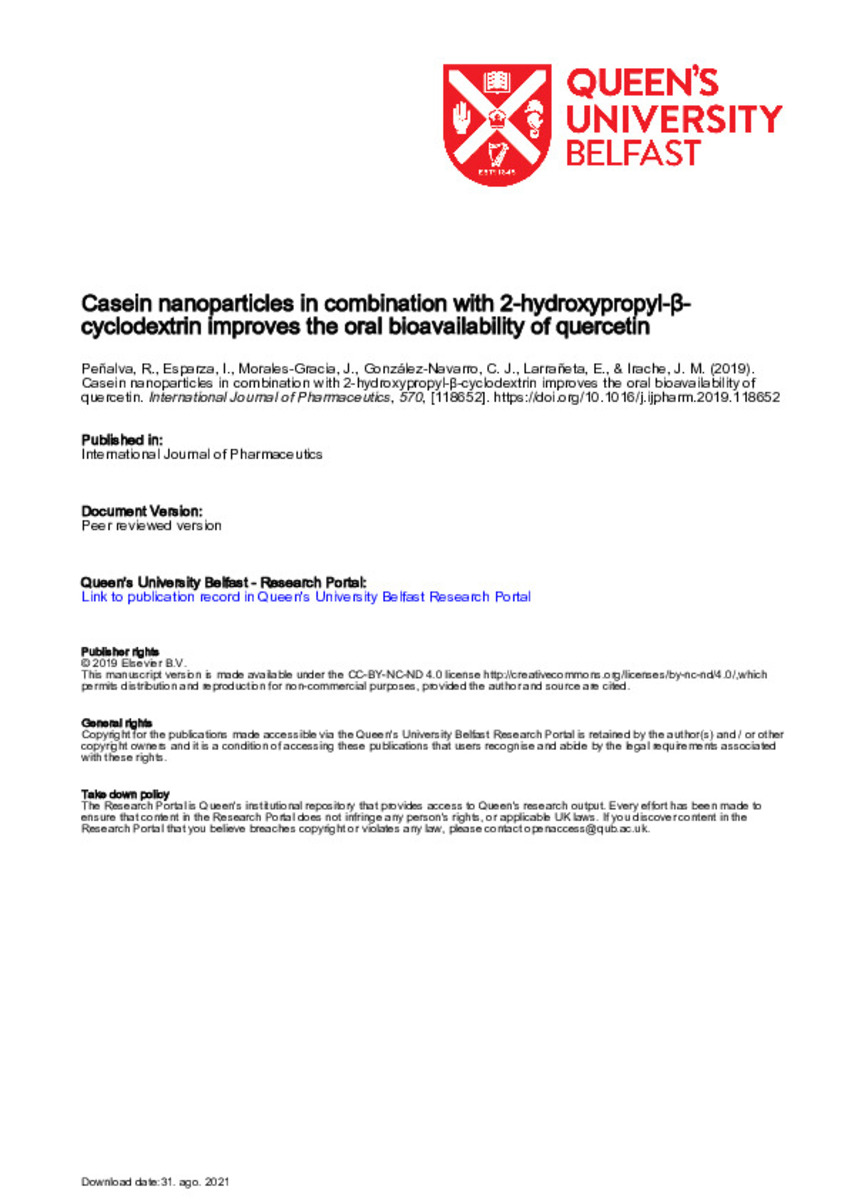Full metadata record
| DC Field | Value | Language |
|---|---|---|
| dc.creator | Peñalva, R. (Rebeca) | - |
| dc.creator | Esparza, I. (Irene) | - |
| dc.creator | Morales, J. (Jorge) | - |
| dc.creator | Gonzalez-Navarro, C.J. (Carlos Javier) | - |
| dc.creator | Larrañeta, E. (Eneko) | - |
| dc.creator | Irache, J.M. (Juan Manuel) | - |
| dc.date.accessioned | 2021-09-02T07:11:23Z | - |
| dc.date.available | 2021-09-02T07:11:23Z | - |
| dc.date.issued | 2019 | - |
| dc.identifier.citation | Peñalva, R. (Rebeca); Esparza, I. (Irene); Morales, J. (Jorge); et al. "Casein nanoparticles in combination with 2-hydroxypropyl-β-cyclodextrin improves the oral bioavailability of quercetin". International Journal of Pharmaceutics. 570, 2019, 118652 | es_ES |
| dc.identifier.issn | 0378-5173 | - |
| dc.identifier.other | PMID: 31472219 | - |
| dc.identifier.uri | https://hdl.handle.net/10171/61902 | - |
| dc.description.abstract | The aim of this work was to optimize the preparative process of quercetin loaded casein nanoparticles as well as to evaluate the pharmacokinetics of this flavonoid when administered orally in Wistar rats. Nanoparticles were obtained by coacervation after the incubation of casein, 2-hydroxypropyl-β-cyclodextrin (HP-β-CD) and quercetin in an aqueous environment. Then, nanoparticles were purified and dried. The resulting nanoparticles displayed a size of 200 nm with a negative zeta potential and a payload of about 32 μg/mg. Release studies showed a zero-order kinetic, suggesting a mechanism based on erosion of the nanoparticle matrix. For the pharmacokinetic study, quercetin was orally administered to rats as a single dose of 25 mg/kg. Animals treated with quercetin-loaded casein nanoparticles displayed higher plasma levels than those observed in animals receiving the solution of the flavonoid (control). Thus, the relative oral bioavailability of quercetin when administered as casein nanoparticles (close to 37%) was found to be about 9-times higher than the oral solution of the flavonoid in a mixture of PEG 400 and water. In summary, the combination of casein and 2-hydroxypropyl-β-cyclodextrin produces nanoparticles that may be a good option to load quercetin for both nutraceutical and pharmaceutical purposes. | es_ES |
| dc.description.sponsorship | This work was supported by the Regional Government of Navarra (Alimentos funcionales, Euroinnova call) and the Spanish Ministry of Science and Innovation and Gobierno de Navarra (ADICAP; ref. IPT-2011-1717-900000). Rebeca Penalva acknowledges the “Asociación de Amigos Universidad de Navarra” for the financial support. | es_ES |
| dc.language.iso | eng | es_ES |
| dc.publisher | Elsevier BV | es_ES |
| dc.rights | info:eu-repo/semantics/openAccess | es_ES |
| dc.subject | Materias Investigacion::Ciencias de la Salud::Química médica | es_ES |
| dc.subject | Nanoparticles | es_ES |
| dc.subject | Cyclodextrin | es_ES |
| dc.subject | Casein | es_ES |
| dc.subject | Quercetin | es_ES |
| dc.subject | Nutraceutical | es_ES |
| dc.subject | Oral delivery | es_ES |
| dc.title | Casein nanoparticles in combination with 2-hydroxypropyl-β-cyclodextrin improves the oral bioavailability of quercetin | es_ES |
| dc.type | info:eu-repo/semantics/article | es_ES |
| dc.description.note | This manuscript version is made available under the CC-BY-NC-ND 4.0 license http://creativecommons.org/licenses/by-nc-nd/4.0/,which permits distribution and reproduction for non-commercial purposes, provided the author and source are cited. | es_ES |
| dc.identifier.doi | 10.1016/j.ijpharm.2019.118652 | - |
| dadun.citation.publicationName | International Journal of Pharmaceutics | es_ES |
| dadun.citation.startingPage | 118652 | es_ES |
| dadun.citation.volume | 570 | es_ES |
Files in This Item:
Statistics and impact
Items in Dadun are protected by copyright, with all rights reserved, unless otherwise indicated.






